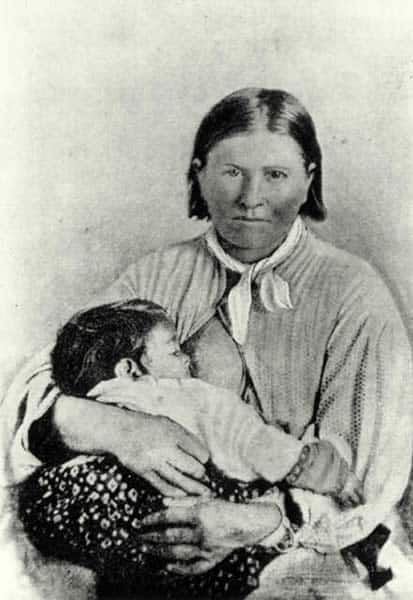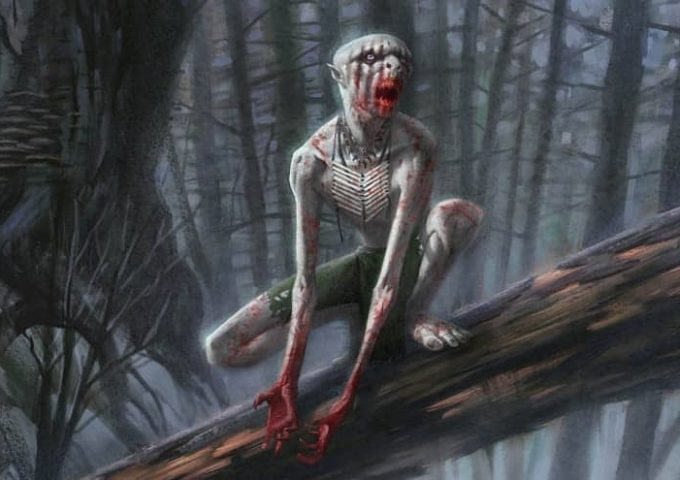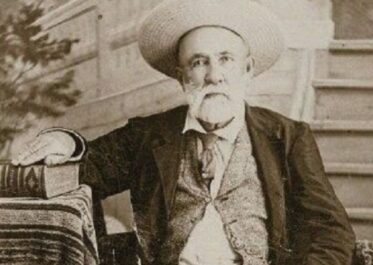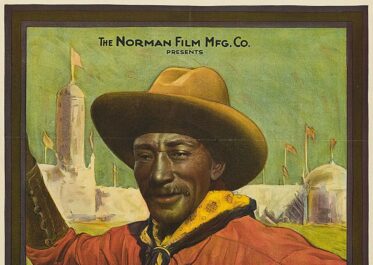10 Facts You May Not Know About Quanah Parker, the “Last Chief of the Comanche”

A large area of today’s Southern and Central Great Plains once formed the boundaries of the most powerful nomadic Native American people in history: the Comanche.
The different Comanche tribes had developed a warring culture based on the expert use of the horse, through the hunting of buffalo and raiding of other tribes. They reached the peak of their power by the late 18th century, becoming the preeminent power of the region. But as the United States expanded West, their power precipitously declined.
The most famous of the Comanches was Quanah Parker, who led them in their last days as an independent power and into life on reservations. He became one of the chief representatives for all Native American people, along with others like Geronimo.
Unlike most well-known indigenous leaders, however, Quanah Parker was one of the few Native Americans who prospered after the move to life on a reservation.
Related read: 50 Native American Proverbs, Sayings & Wisdom Quotes
10 Interesting Facts About Quanah Parker
1. Quanah Parker’s mother was captured by Comanches.
Any discussion about Quanah Parker must begin with his mother, Cynthia Ann Parker. She was the daughter of white settlers who had built a compound called Fort Parker at the headwaters of the Navasota River in east-central Texas. In May 1836, Comanche and Caddo warriors raided Fort Parker and captured nine-year-old Cynthia Ann and her little brother John.

Capturing children was a common practice among the Comanche, and children would either be ransomed back or assimilated into Comanche culture. Cynthia Ann, who was admired for her toughness and striking blue eyes, was assimilated into the Comanche culture. She was adopted to the Quahade tribe and given the name Nau-u-day, meaning “Someone Found.”
According to American History, War Chief Peta Nocona took Cynthia Ann as one of his wives. She then bore three children: Quanah, who was born between 1845 and 1850, Pee-nah (“Peanuts”), and Toh-Tsee-Ah (“Prairie Flower”).
Related read: When Did the Wild West Really End?
2. Quanah Parker’s grandfather was a fierce fighter.
Quanah Parker’s mother’s story is certainly dramatic, but his father’s lineage is also compelling. Quanah’s paternal grandfather was Pobishequasso, better known as the fierce war chief and medicine man “Iron Jacket.”
The name, according to the Texas State Historical Association, came about when he acquired a set of Spanish chainmail armor at some unknown point. Iron Jacket used this to good effect, impressing fellow Comanches with his ability to turn away missiles. His reputation was such that he could blow arrows away.
Iron Jacket’s charmed life came to an end on May 12, 1858, when Texas Rangers John S. Ford and Shapely P. Ross, supported by Brazos Reservation Native Americans, raided the Comanche at the banks of the South Canadian River.
S.C.Gwynne, in Empire of the Summer Moon, explains that Iron Jacket, with a false sense of security, came forward in full regalia. He urged his horse forward, rode it in a circle, and blew out hard in challenge. While at first his mailshirt held true, at last six-shooters and Mississippi rifles killed the semi-legendary war chief.
The demoralized Comanche broke and ran.
Quanah’s father, Peta Nocona, was also highly revered as a war chief. He led raids on the Texas frontier from the 1830s until December 18, 1860, when he was purportedly killed in battle with Captain Lawrence Sullivan Ross at the Pease River. Decades later, Quanah denied that his father was killed by Ross, and claimed he died later.
However, after the Battle of Pease River, there is no further mention of Peta Nocona.
Related read: 10 Places to See Native American Pictographs & Petroglyphs in the West
3. Quanah Parker’s name may not be his real one.
The meaning of Quanah’s name is unclear. According to S.C.Gwynne, the name may derive from the Comanche word kwaina, which means fragrant or perfume. However, descendants have said that he was originally named Kwihnai, which means “Eagle.” This has led some to surmise that Quanah is actually a nickname.
If that is the case, then why would he have been nicknamed “fragrant?” There is a legend, as related by American History, that Quanah was born on a bed of wildflowers. However, it is possible that “Quanah” is more related to the Shoshone root work kwanaru, which means “stinking” and was meant more as an insult.
Regardless, Quanah did not adopt his surname Parker until later in life. When he did so, his name became a homage to two different worlds: traditional Comanche culture and that of white American settlers.

In fact, Quanah Parker as a historical figure does not appear in the records until after the Battle of Adobe Walls in June 1874. As explained in Wild West, Quanah led a party of up to 300 Comanche and Kiowa warriors against 28 buffalo hunters at a trading post on the Canadian River.
The attack was repulsed and Quanah himself was wounded. It was perhaps this incident that started the Red River War, which finished Comanche power, that made Quanah conclude that fighting against the whites was a losing proposition. From that time on, Quanah walked between two worlds, starting by surrendering his Comanches to the Americans the next year.
Related read: 10 Revealing Facts About Isaac Parker, the Old West’s “Hanging Judge”
4. Quanah Parker’s mother starved herself to death.
When Quanah surrendered in 1875, he did not know the whereabouts of his mother. Cynthia Ann Parker had been missing from Quanah’s life since December 1860, when a band of Texas rangers raided a Comanche hunting camp at Mule Creek, a tributary of the Pease River.
In the melee, the Texans recaptured Parker and her infant daughter, Prairie Flower. Cynthia Ann, who was fully assimilated to Comanche culture, did not wish to go, but she was compelled to return to her former family.
In fact, she became a totem of the white man’s conquest of the West, and put on display. As one account described, “She stood on a large wooden box, she was bound with rope. She made a pathetic figure as she stood there, viewing the crowds that swarmed about her. The tears were streaming down her face, and she was muttering in the Indian language.”
Her case became famous, and the Texas Legislature, upon hearing of her story, authorized a $100 annual grant payment for five years. However, she retreated from white society and fell into depression, which grew worse after the death of Prairie Flower in 1864 from fever. Perhaps from self-inflicted starvation, influenza took Cynthia Ann Parker’s life probably in 1871.
Related read: 7 Remarkable Native American Women from Old West History
5. Quanah Parker became Chief of the Comanche, but wasn’t chosen by them.
Quanah Parker’s surrender at Fort Sill to American authorities in 1875 was a turning point, not just for the Comanches, but for him personally. He and his band of some 100 Quahades settled down to reservation life and Quanah promised to adopt white ways.
When he surrendered, he only identified himself to Colonel Ranald Mackenzie as a war chief of the Comanches. However, within a short time, government agents from the Bureau of Indian Affairs, probably recognizing Quanah’s innate intelligence and leadership abilities, designated him as the Chief of the Comanche nation.

However, the Comanches never had a chief with central authority. Despite the criticisms of some fellow Comanche, Quanah had no objection to the promotion. As American History explains, his stationary read: “Principal Chief of the Comanche Indians.” It was in this role that Quanah urged his fellow Comanches to take up farming and ranching.
Related read: The Fighting Men & Women of the Fetterman Massacre
6. Quanah Parker became the wealthiest Native American in the United States.
Quanah Parker was different from other Native American leaders in that he had grown wealthy after his submission. Under Quanah, the Comanches became relatively successful at ranching and profited by leasing their land to cattle barons as grazing space.
He took that money and invested it in real estate and railroad stock. He was successful enough that he was deemed to be the wealthiest Native American in the United States by the turn of the 20th century.
Eventually, Quanah decided to abandon a traditional Comanche tipi. He had a two-story, ten-room house built for himself in the foothills of the Wichita Mountains in Oklahoma. He had 12 stars painted on the roof so that he could apparently outrank any general that visited him. He dubbed his home the “Star House.” He expanded his home steadily over the years and today it’s on the National Register of Historic Places.

At the Star House, he hosted influential whites, cementing his role as a leading spokesperson of Native Americans in the United States. This influence expanded as he traveled widely on business and political affairs. In fact, a town in Texas was named after him, he served as a judge on Comanche affairs, and consulted with white authorities on policy.
Whites saw Quanah as a valuable leader who would be willing to help assimilate Comanches to white society. More conservative Comanche critics viewed him as a sell out. However, Quanah was not a mere stooge of the white government: his evident plan was to promote his own people as best he could within the confines of a society that oppressed them.
Related read: The Brief & Heinous Rampage of the Rufus Buck Gang
7. Quanah Parker had seven wives and was very fertile.
One way Quanah maintained his position was by being able to maintain Comanche traditions. For example, he refused to cut his traditional braid. More important, as described by historian Rosemary Updyke, Comanche custom dictated that a man may have as many wives as he could afford.

Quanah had seven or eight if you include his first wife who was an Apache, and who could not adapt to Comanche ways. Weckeah bore five children, Chony had three, Mahcheetowooky had two children, Aerwuthtakeum had another two, Coby had one child, Topay four (of which two survived infancy), and Tonarcy, who was his last wife, had none. Quanah Parker has many descendants.
White society was very critical of this aspect of Quanah’s life, even more than of his days raiding white settlements. The Bureau of Indian affairs even reported Quanah’s wives as “mothers” rather than refer to the open polygamy. When pressed by authorities to just have one wife, Quanah impishly agreed and told the official, “but you must tell the others.”
Read next: The Many Lives of Olive Oatman, Tattooed Captive of the West
8. Quanah Parker laid the foundations for the Native American Church.
Quanah also was a devotee of Comanche spiritual beliefs. He rejected traditional Christianity even though, according to the Texas State Historical Association, one of his sons, White Parker, was a Methodist minister.
While the Comanches did not have an organized religion, Quanah freely mixed his own style of Christianity with peyote use. The hallucinogenic cactus was seen as a means of coping with the emasculation of the once virile Comanche culture. Quanah’s own use was regular and he often led fellow Native Americans through the sacred Half Moon ceremony.
Whites who had business dealings with the chief were surprised he was not impaired by peyote. When efforts were made by the government to suppress peyote use, Quanah used quiet advocacy and diplomacy. His general strategy was to agree to suppress it while covertly supporting it.
However, he also overtly supported peyote, testifying to the Oklahoma State Legislature, “I do not think this Legislature should interfere with a man’s religion; also these people should be allowed to retain this health restorer. I do think peyote has helped Indians to quit drinking.”
Quanah also successfully smuggled peyote in when government agents destroyed crops at its source. He is considered a founder of the Native American Church for these efforts.
9. Quanah Parker was friends with President Theodore Roosevelt.
Quanah Parker had become one of the preeminent representatives of Native Americans to white society. One of his most powerful connections was President Theodore Roosevelt. Historian Rosemary Updyke, describes how Roosevelt met Quanah when he visited Indian Territory for a reunion of his regiment of Rough Riders from the Spanish-American War.
Quanah was asked to lead a parade of Comanche warriors as part of the celebration. The two began a friendship which was cemented by hunting together. This extended into Roosevelt’s presidency, when the two hunted wolves together in 1905.
Like other whites, Roosevelt viewed Quanah as a model of assimilation, but also listened to Quanah on Comanche issues of employment and prosperity. Roosevelt said, “Give the red man the same chance as the white. The country is founded on the doctrine of giving each man a fair show to see what is in him.”

Roosevelt visited Quanah’s Star House and from this meeting stemmed the repatriation of fifteen bison from the Bronx Zoo to the newly created Wichita Mountain Wildlife Refuge. Quanah was greatly excited for the return of the nearly extinct animal that was emblematic of the Comanche way of life.
Related read: 10 Important Battles & Fights of the Great Sioux War
10. Quanah Parker’s grave was robbed and then moved.
Quanah Parker died on February 23, 1911, of pneumonia at Star House. He was originally buried by his mother at the Post Oak Mission in Oklahoma. With the dead chief were buried some valuables as a mark of his status.
In May 1915, one or more graverobbers opened the grave and stole three rings, a gold watch chain, and a diamond broach. The criminals were never found. Instead, Quanah’s family cleaned the bones and reburied him in a new casket.

This was not the end of Quanah Parker: in 1957, Fort Sill was expanding its missile firing ranges, which encompassed the Post Oak Mission. As a result, both Quanah and Cynthia Ann Parker were disinterred, with the bodies moved to the Fort Sill cemetery in Lawton, Oklahoma.
The monument which guards his grave reads:
Resting Here Until Day Breaks
And Shadows Fall And Darkness
Disappears Is
Quanah Parker
Last Chief Of The Comanches
What to Read Next
- 5 Spectacular Native American Ruins in Colorado You Can Visit Today
- Flint Knapping: Stone Age Technology that Built the First Nations
- 10 Native American Mythical Creatures, from Thunderbirds to Skinwalkers
- The Complicated Legacy of Peacemaker Ute Chief Ouray
- 15 Native American Ruins in Arizona that Offer a Historic Glimpse into the Past
References & Further Reading
OldWest.org strives to use accurate sources and references in its research, and to include materials from multiple viewpoints and angles when possible.
- Fehrenbach, T. R. (2003). Comanches: The History of a People. Anchor Books.
- Frankel, G. (2014). The Searchers: The Making of an American Legend. Bloomsbury.
- Gwynne, S. C. (2011). Empire of the Summer Moon: Quanah Parker and the Rise and Fall of the Comanches, the Most Powerful Indian Tribe in American History. Scribner.
- Hagan, W. T. (1995). Quanah Parker, Comanche Chief. University of Oklahoma Press.
- Kissinger, R. K. (1992). Quanah Parker: Comanche Chief. Pelican Pub. Co.
- Neeley, B. (1997). The Last Comanche Chief: The Life and Times of Quanah Parker. John Wiley & Sons.
Joseph A. Williams is an author, historian, and librarian based in Connecticut. He has authored three books: The Sunken Gold, Seventeen Fathoms Deep, and Four Years Before the Mast.






What a time to be alive
Two Facts from being a Cousin to Quanah Parker and hearing True Stories from family members at our Annual Family Reunion, that Book Summer Moon one, is Based on White Mans Lies and AND that IS his REAL Name